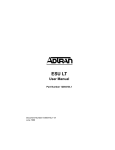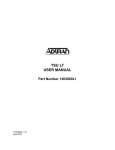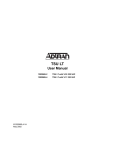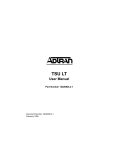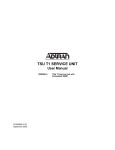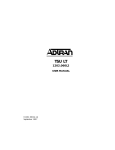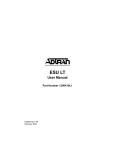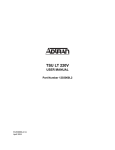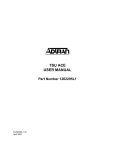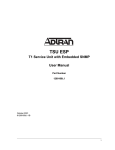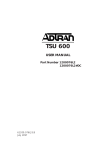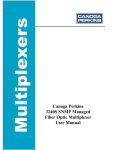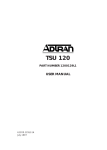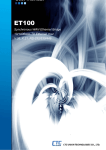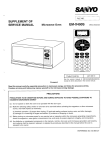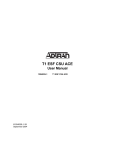Download ADTRAN T1-FT1 User's Manual
Transcript
TSU T1-FT1 Data/Channel Service Unit Part Number 1200060L1 User Manual 61200060L1-1B September 1999 901 Explorer Boulevard P.O. Box 140000 Huntsville, AL 35814-4000 (256) 963-8000 © 1999 ADTRAN, Inc. All Rights Reserved. Printed in U.S.A. Notes provide additional useful information. Cautions signify information that could prevent service interruption. Warnings provide information that could prevent damage to the equipment or endangerment to human life. iii FCC regulations require that the following information be provided to the customer in this manual. 1. This equipment complies with Part 68 of the FCC rules. The required label is affixed to the bottom of the chassis. 2. If your telephone equipment causes harm to the telephone network, the Telephone Company may discontinue your service temporarily. If possible, they will notify you in advance. But if advance notice isn’t practical, you will be notified as soon as possible. You will be advised of your right to file a complaint with the FCC. 3. Your telephone company may make changes in its facilities, equipment, operations, or procedures that could affect the proper operation of your equipment. If they do, you will be given advance notice so as to give you an opportunity maintain uninterrupted service. 4. If you experience trouble with this equipment, please contact Adtran at 888-4Adtran for repair/warranty information. The telephone company may ask you to disconnect this equipment from the network until the problem has been corrected, or until you are sure the equipment is not malfunctioning. 5. This unit contains no user-serviceable parts. 6. An FCC compliant telephone cord and modular plug is provided with this equipment. This equipment is designed to be connected the telephone network or premises wiring using a compatible modular jack which is Part 68 compliant. See installation instructions for details. 7. The following information may be required when applying to your local telephone company for leased-line facilities. iv Service REN/SOC FIC USOC 1.544 Mbps - SF 6.0/F 04DU9-BN RJ48C 1.544 Mbps - SF and B8ZS 6.0/F 04DU9-DN RJ48C 1.544 Mbps - ESF 6.0/F 04DU9-1KN RJ48C 1.544 Mbps - ESF and B8ZS 6.0/F 04DU9-1SN RJ48C Federal Communications Commission Radio Frequency Interference Statement This equipment has been tested and found to comply with the limits for a Class A digital device, pursuant to Part 15 of the FCC Rules. These limits are designed to provide reasonable protection against harmful interference when the equipment is operated in a commercial environment. This equipment generates, uses, and can radiate radio frequency energy and, if not installed and used in accordance with the instruction manual, may cause harmful interference to radio frequencies. Operation of this equipment in a residential area is likely to cause harmful interference, in which case the user will be required to correct the interference at his own expense. Shielded cables must be used with this unit to ensure compliance with Class A FCC limits. Change or modifications to this unit not expressly approved by the party responsible for compliance could void the user’s authority to operate the equipment. v Important Safety Instructions When using your telephone equipment, please follow these basic safety precautions to reduce the risk of fire, electrical shock, or personal injury: 1. Do not use this product near water, such as near a bath tub, wash bowl, kitchen sink, laundry tub, in a wet basement, or near a swimming pool. 2. Avoid using a telephone (other than a cordless-type) during an electrical storm. There is a remote risk of shock from lightning. 3. Do not use the telephone to report a gas leak in the vicinity of the leak. 4. Use only the power cord, power supply, and/or batteries indicated in the manual. Do not dispose of batteries in a fire. They may explode. Check with local codes for special disposal instructions. SAVE THESE INSTRUCTIONS vi WARRANTY AND CUSTOMER SERVICE ADTRAN will replace or repair this product within five years from the date of shipment if the product does not meet its published specifications or if it fails while in service. For detailed warranty, repair, and return information see the ADTRAN Equipment Warranty and Repair and Return Policy Procedure on the inside back page of this manual. Return Material Authorization (RMA) is required prior to returning equipment to ADTRAN. For service, RMA requests, or more information, contact one of the numbers found on the inside back page of this manual. vii viii Table of Contents Chapter 1. Introduction .......................................................................................... 1-1 T1/FT1 Overview ..................................................................................................... 1-1 T1 Service Offerings........................................................................................... 1-1 Fractional T1........................................................................................................ 1-2 TSU Overview ........................................................................................................... 1-3 Functional Description ...................................................................................... 1-3 Features ....................................................................................................... 1-5 Interfaces ..................................................................................................... 1-5 Network Interface .............................................................................................. 1-6 NI .................................................................................................................. 1-6 Nx56/64 Serial Interface ........................................................................... 1-6 Control Port Input ...................................................................................... 1-6 Chain Port Output ..................................................................................... 1-6 Three Methods of Control................................................................................. 1-7 Front Panel .................................................................................................. 1-7 Adtran PC Program ................................................................................... 1-7 SNMP ........................................................................................................... 1-7 TSU Clock Sources ............................................................................................. 1-8 Network Timed .......................................................................................... 1-8 DTE Timed .................................................................................................. 1-9 Internal Timing ......................................................................................... 1-10 TSU Testing ....................................................................................................... 1-11 Self Tests .................................................................................................... 1-11 Loopback Tests ......................................................................................... 1-11 Network Loopbacks ......................................................................... 1-12 DTE Interface Loopbacks ................................................................. 1-13 Pattern Generation ................................................................................... 1-13 All Ones .............................................................................................. 1-13 3 in 24 .................................................................................................. 1-13 511 ....................................................................................................... 1-14 1 in 8 .................................................................................................... 1-14 Application........................................................................................................ 1-14 Chapter 2. Installation ............................................................................................ 2-1 61200060L1-1 TSU User Manual ix Table of Contents Unpack, Inspect, Power Connection ...................................................................... 2-1 ADTRAN Shipments Include ........................................................................... 2-1 Customer Provides............................................................................................. 2-1 Power Connection .............................................................................................. 2-1 Wiring .........................................................................................................................2-2 Network ............................................................................................................... 2-2 Control In/Chain In ................................................................................... 2-3 Chain Out .................................................................................................... 2-4 Nx56k/64k DTE (V.35) .............................................................................. 2-5 Power Up Testing and Initialization ...................................................................... 2-6 Self Test ................................................................................................................ 2-6 Chapter 3. Operation............................................................................................... 3-1 Methods of operation ............................................................................................... 3-1 Front Panel Operation ....................................................................................... 3-2 General Menu Operation .................................................................................. 3-3 Data Field .................................................................................................... 3-3 Display Field ............................................................................................... 3-3 Arrows ......................................................................................................... 3-3 Example Menu Operation ......................................................................... 3-3 Setting the Data Field ................................................................................ 3-4 Viewing Display Only Data Fields .......................................................... 3-5 To Exit Any Menu Field Operation or Display ...................................... 3-5 Menu Structure ................................................................................................... 3-6 The Four Opening Menu Functions ................................................................ 3-7 STATUS ....................................................................................................... 3-7 NI PERF RPTS ..................................................................................... 3-7 CURR ERR/ALM ................................................................................ 3-7 ERR/ALM HIST .................................................................................. 3-7 CONFIG ....................................................................................................... 3-7 NETWORK (NI) .................................................................................. 3-7 UNIT ..................................................................................................... 3-7 PORT ..................................................................................................... 3-7 UTIL ............................................................................................................. 3-8 TIME/DATE ........................................................................................ 3-8 SOFTWARE VERSION ...................................................................... 3-8 REINIT UNIT ....................................................................................... 3-8 ADDRESS ............................................................................................. 3-8 FACT RESTORE .................................................................................. 3-8 TEST ............................................................................................................. 3-8 NETWORK TESTS .............................................................................. 3-8 RUN SELF TEST .................................................................................. 3-8 x TSU User Manual 61200060L1-1 Table of Contents PORT TESTS ........................................................................................ 3-8 Menu Operation ....................................................................................................... 3-9 Status Menu ........................................................................................................ 3-9 NI PERF RPTS, Submenu of 1)Status .................................................... 3-10 CURR ERR/ALM Submenu of 1)Status ............................................... 3-12 ERR/ALM Hist Submenu of 1)Status ................................................... 3-13 Configuration.................................................................................................... 3-14 1) NETWORK (NI) SUBMENU OF 2) CONFIG .................................. 3-15 2) UNIT, SUBMENU OF 2) CONFIG .................................................... 3-17 1) CNTRL PORT ................................................................................ 3-17 2) ALARMS ........................................................................................ 3-18 3) PORT, SUBMENU OF CONFIG ........................................................ 3-19 UTIL ................................................................................................................... 3-21 1)Time/Date, Submenu of 3)Util ........................................................... 3-21 2)Software Rev, Submenu of 3)Util ....................................................... 3-23 3)Reinit Unit, Submenu of 3)Util ........................................................... 3-23 4)Address,Submenu of 3)Util ................................................................. 3-24 5)Fact Restore, Submenu of 3)Util ......................................................... 3-24 Test ..................................................................................................................... 3-25 1)Network Tests, Submenu of 4)Test .................................................... 3-26 2)Run Selftest, Submenu of 4)Test ......................................................... 3-28 3)Port Tests submenu of 4)Test .............................................................. 3-29 Chapter 4. Testing Example................................................................................... 4-1 Far End Looped Back Test ................................................................................ 4-1 Network Interface Test .............................................................................. 4-1 Index ................................................................................................................. Index-1 61200060L1-1 TSU User Manual xi Table of Contents xii TSU User Manual 61200060L1-1 List of Figures Figure 1-1. Figure 1-2. Figure 1-3. Figure 1-4. Figure 1-5. Figure 1-6. Figure 1-7. Figure 1-8. Figure 1-9. Figure 3-1. Figure 3-2. Figure 3-3. Figure 3-4. Figure 3-5. Figure 3-6. Figure A-1. Figure B-1. 61200060L1-1 TSU .......................................................................................................1-3 TSU Rear Panel ..................................................................................1-4 TSU Interfaces .....................................................................................1-5 Network Timed Clock Source ...........................................................1-8 DTE Clock Source ...............................................................................1-9 Internal Clock Source .......................................................................1-10 Network Loopback Tests .................................................................1-12 DTE Interface Loopback ..................................................................1-13 Simple Bridge Application on a T1 or FT1 Circuit ......................1-14 Front Panel Layout .............................................................................3-2 The Four Opening Menus ................................................................3-6 Complete Status Menu .......................................................................3-9 Complete Configuration Menu ......................................................3-14 Complete Utility Menu ....................................................................3-21 Complete Test Menu ........................................................................3-25 TSU Complete Menu Diagram ........................................................A-1 DTE DATA RATE CHART .............................................................. B-1 TSU User Manual xiii List of Figures xiv TSU User Manual 61200060L1-1 List of Tables Table 2-1. Table 2-2. Table 2-3. Table 2-4. Table 3-1. 61200060L1-1 Network Pin Connection ...................................................................2-2 Control In/Chain In Pin Connection ...............................................2-3 Chain Out Pin Connection ................................................................2-4 Primary V.35 Pin Connection ...........................................................2-5 Normal Mode of Operation ............................................................3-20 TSU User Manual xv List of Tables xvi TSU User Manual 61200060L1-1 Chapter 1 Introduction T1/FT1 OVERVIEW T1 digital communication links have been used by the transmitting companies (Telcos) for the transmitting of voice since the early sixties. The D4 channel bank is an example of a T1 digital carrier system that was introduced in the mid seventies and is still widely used by the Telcos. Communication demands of businesses continued to grow to the point that the Telcos began offering T1 service directly to the public. D4 channel banks began to be used for T1 in corporate network topographies for voice. The technological advances in computer development created a demand also for T1 data communication which now is a large part of the T1 traffic. T1 Service Offerings T1 is a digital service that is delivered to the user over two pairs of wires from the service provider. The signal operates at 1.544Mbps and is usually extended by repeaters that are installed about every mile after the first 6000 feet. The T1 signal is divided into 24 time slots which operate at 64 kbps (DS0s). Each time slot is occupied by digitized voice or by data. The T1 signal originally used a type of framing known as D4 Superframe which identifies how the T1 is multiplexed. An enhancement of that framing format is available now called Extended Superframe (ESF). ESF provides a non-disruptive means of full time monitoring on the digital facility. It was originally used by the service provider to monitor the 61200060L1-1 TSU User Manual 1-1 Chapter 1. Introduction performance of their service offering. Since the introduction of ESF, equipment that is installed in private networks can also provide the same performance information to the user. Fractional T1 Fractional T1 lets the buyer purchase less than a full T1 circuit between two points. Most carriers offer fractional T1 in increments of 56 or 64 kbps. Connection is made to the same network elements. The network allows multiple users to share the same interoffice T1 bandwidth. Fractional T1 remains almost exclusively an Inter-Exchange Carrier (IXC) service. Local Exchange Carriers (LECs) typically do not offer FT1, so the user's proximity to the IXC's point of presence (POP) is key in the savings that fractional T1 offers. Fractional T1 local access is available in two forms, 56kbps or a full T1 line. In 56 kbps the required number of DDS lines is extended from the IXC POP and the bandwidth is combined at the office on an outbound T1 circuit. The user pays for the individual 56K lines and the amount of the interoffice T1 utilized. In T1 access, the user pays for a full T1 to the IXC POP and then only for the bandwidth utilized. 1-2 TSU User Manual 61200060L1-1 Chapter 1. Introduction TSU OVERVIEW TSU ENTER SCROLL CANCEL Figure 1-1. TSU Functional Description The ADTRAN TSU is one of several T1 multiplexers that offers complete flexibility for connection of various data sources to T1 or FT1 facilities. This family of TSU multiplexers includes the following. 1. TSU - a T1 CSU/DSU with a single NX56k/64k serial port. See Figure 1-1, above and Figure 1-2 on page 1- 4. 2. TSU 100 - same as the TSU with the added feature of a slot in the rear panel to house an option module. Each module offers up to four additional data ports. 3. TSU 600 - same as the TSU with the added feature of six slots in the rear panel to house up to six option modules. Each module offers up to four additional data ports for a total of 24 possible data ports. The TSU serves as the link between user data sources such as LAN bridges and routers, computers, CAD systems and teleconferencing equipment. The amount of bandwidth allocated to the port is custom programmable. The DTE data can occupy contiguous or alternate channels in the T1 stream, and the channels may start at any position. 61200060L1-1 TSU User Manual 1-3 Chapter 1. Introduction 1 2 3 4 5 6 7 8 9 ON TEST JACKS CONTROL OFF NETWORK IN OUT MON CHAIN IN CHAIN OUT Item 1. Network 115VAC/60HZ .15A V.35 NX56/64 Function T1-FT1 Network Interface Test Jacks 2. IN Bantam Test Jack 3. OUT Bantam Test Jack 4. MON (Monitor) Bantam Test Jack Control 5. Chain In Interface of Chain In 6.Chain Out Connects to Chain In of another TSU 7. V.35 Nx56/64 DTE Port 8. Power Switch Used to turn power On or OFF 9. Power Cord Captive 3 Prong Power cord Figure 1-2. TSU Rear Panel 1-4 TSU User Manual 61200060L1-1 Chapter 1. Introduction Features • A DS1 interface and an Nx56/64 DTE serial interface port. • Easy configuration capabilities using simplistic menus displayed in a Liquid Crystal Display (LCD) window operated by a front panel keypad. • Timing is selectable from the network, from the Nx56/64 DTE port, or internally. • All ones, 3:24, 511 and 1:8 Test Patterns. • Extensive self test and monitoring provides assurance of proper operation. • Flexible channel allocation (any starting channel and alternate or contiguous). Interfaces The TSU is equipped with four interfaces. See Figure 1-3. • Network DSI interface per AT&T 621411 • Nx56/64 serial V.35 high speed interface • Control input (RS232) / Chain port input • Chain port output PC or Modem Control Input NI Network Chain Output Chain Input TSU Nx56/64 NI Chain Output TSU Nx56/64 Figure 1-3. TSU Interfaces 61200060L1-1 TSU User Manual 1-5 Chapter 1. Introduction Network Interface The Network Interface (NI) port complies with the applicable ANSI and AT&T standards. NI • AMI or B8ZS coding • Automatic or manual line build out • D4 or ESF framing • Network performance monitoring and reporting • Test loopbacks by local and remote • Extensive self test Nx56/64 Serial Interface • Data rates: N*56k or N*64k, where N=1 to 24 (DS0s) • Inverted data (Inverted HDLC) • A V.35 interface • Standard V.35 connectors • Test loopbacks with 511 pattern generation and check • Extensive self test Control Port Input • EIA-232 input from a PC or a modem for control of the TSU • Chain input from another TSU • Up to 9600 baud operation • Acts as input for PC proxy agent control or as input for a chained connection Chain Por t Output 1-6 • EIA-232 output to chain control to other TSUs • Up to 9600 baud operation • Automatic setup; no user input required TSU User Manual 61200060L1-1 Chapter 1. Introduction Three Methods of Control Front Panel The front panel provides complete and easy control of all items that can be configured through menu guided options. The front panel LCD also displays the status of operation and performance reports for the unit. A complete discussion of the operation of the front panel and all the menu options is found in Chapter 3, Operation. Adtran PC Program T-WATCH is the ADTRAN PC control program. It provides complete control over the configuration of the TSU using a graphic interface. The T-WATCH program displays the same status and performance data as the front panel LCD. This data is displayed in the form of tables and graphs. The T-WATCH program has the following capabilities. 1. Interfaces with a modem which permits dialing into a remote TSU location to configure the unit or read the unit’s status or performance. 2. The performance data read from the units can be exported in a file which is compatible with common spread sheet programs. SNMP The ADTRAN TSU will support the Simple Network Management Protocol (SNMP) through an ADTRAN proxy agent in mid 1994. The proxy agent runs on a PC and can interface to the TSU directly or via a modem, in the same manner as the T-WATCH PC program. 61200060L1-1 TSU User Manual 1-7 Chapter 1. Introduction TSU Clock Sources The TSU is operable from various clock sources permitting it to perform properly in many different applications. The network interface clocking options are set by using the Network (NI) Configuration menu options. There are three clock source options available. • Network • DTE Timed • Internal Timing The clocking option selected always designates the clock source for transmission. Clocking necessary for receiving data will always be recovered from incoming data. Network Timed The network is the source of timing. The received data clocking is looped back to the network where it is used to determine the transmission timing. This option is also referred to as looped timed as the transmission clock is derived from the received clock. See Figure 1-4. OSC T1 XMIT (DSU) T1 Receive Network Interface NX56K/64K DTE CLOCK DTE Figure 1-4. Network Timed Clock Source 1-8 TSU User Manual 61200060L1-1 Chapter 1. Introduction DTE Timed The DTE is the source of timing. The TSU uses the incoming DTE clock to determine the transmission timing. This is typically used in applications where it is necessary to have the DTE as the Primary Clock Source, (such as limited distance line drivers). See Figure 1-5. OSC T1 XMIT (DSU) T1 Receive Network Interface NX56K/64K DTE CLOCK DTE Figure 1-5. DTE Clock Source 61200060L1-1 TSU User Manual 1-9 Chapter 1. Introduction Internal Timing The TSU is the source of timing. The TSU is configured to use its own internal oscillator as the source of timing. Applications include private line driver circuits where one end is set to network and the other to internal. See Figure 1-6. OSC T1 XMIT (DSU) T1 Receive Network Interface NX56K/64K DTE CLOCK DTE Figure 1-6. Internal Clock Source 1-10 TSU User Manual 61200060L1-1 Chapter 1. Introduction TSU Testing Currently the TSU offers three forms of testing. • Self Test • Loopback Tests • Pattern generation and check Self Tests The self test checks the integrity of the internal operation of the electronic components by performing memory tests and by sending and verifying data test patterns through all internal interfaces. Although actual user data cannot be passed during these tests, the self test can be run with the network and DTE interfaces in place and will not disturb any external interface. The self test automatically executes upon power up. It can also be commanded from a front panel menu or from the control port. In addition to the specified self tests, background tests are also run on various parts of the internal electronics. These will run during normal operation to confirm continued correct functioning. The background tests include; 1) monitoring the phase locked loop for lock, 2) the standard background network performance monitoring, as required by ANSI T1.403 andAT&T 54016 for which the results are stored. Loopback Tests A number of different loopbacks can be invoked locally from the front panel, by T-WATCH commands or remotely by using special inband codes (AT&T D4 network loop up and loop down codes; V.54 loop up/loop down codes for the Nx56k/64k serial interface). Additionally the loopbacks can be remotely controlled by out-of-band commands via the T1 ESF FDL, or from T-WATCH via a modem connection. 61200060L1-1 TSU User Manual 1-11 Chapter 1. Introduction Network Loopbacks There are two types of network loopbacks; see Figure 1-7. • Line Loopback: loops all of the received data back toward the network. The transmitted data is the identical line code that was received, including any bipolar violations or framing errors. • Payload Loopback: similar to Line loopback, except that the framing is extracted from the received data and then regenerated for the transmitted data. TSU V.35 NI CSU DS1 Interface Payload Loopback Line Loopback Figure 1-7. Network Loopback Tests 1-12 TSU User Manual 61200060L1-1 Chapter 1. Introduction DTE Interface Loopbacks The Nx56k/64k serial interface offers a DTE loopback. See Figure 1-8. DTE Loopback: loops all data from the DTE back towards the DTE. This loopback may be initiated by the DTE asserting the Local Loopback (LL) input on the connector or by using front panel or T-WATCH commands. The DTE (or external test equipment) must provide any test pattern in order to check the DTE interface. DTE Loopback TSU Nx56/64 Interface Nx56/64 to network control circuit Network Interface (NI) T1 to DTE Figure 1-8. DTE Interface Loopback Pattern Generation The TSU offers four available test patterns, All Ones, 3:24, and 511 and 1:8. All Ones Need definition 3 in 24 The 3:24 is a stress pattern which places the maximum number of 0s in the transmitted data. This is always done over all DS0s. This pattern is used in conjunction with external test equipment to determine if the T1 line is preforming acceptably under a stress condition. 61200060L1-1 TSU User Manual 1-13 Chapter 1. Introduction 511 The 511 pattern is generated and checked by the Nx56k/64k serial interface. It only appears in the DS0s assigned to the Nx56k/64k port. When used in conjunction with the payload loopback at the far end as previously described, an end to end integrity check can be made on the DTE ports. 1 in 8 The 1:8 pattern is used similarly to the 3:24. Each channel of the T1 has only one bit set. Application Using the V.35 DTE interface, a bridge or router can be interfaced to the network. The bandwidth used is programmable at Nx56 or Nx64 data rates for T1 or FT1 service. The bandwidth can be selected as contiguous or alternate. See Figure 1-9. Bridge Router NX56/64 V.35 TSU TSU (Public T1) NX56/64 Bridge Router V.35 Figure 1-9. Simple Bridge Application on a T1 or FT1 Circuit 1-14 TSU User Manual 61200060L1-1 Installation Chapter 2 UNPACK, INSPECT, POWER CONNECTION Carefully inspect the TSU for any shipping damages. If damage is suspected, file a claim immediately with the carrier and then contact ADTRAN Customer and Product Service. If possible, keep the original shipping container for use in shipping the TSU back for repair or for verification of damage during shipment. ADTRAN Shipments Include • The TSU unit • Line interface cable: an 8-position/modular to 8position modular • The TSU User Manual Customer Provides • DTE cable(s) • Cable for Supervisory Port, if used Power Connection Each TSU unit is provided with a captive eight-foot power cord, terminated by a three-prong plug which connects to a grounded power receptacle. 61200060L1-1 TSU User Manual 2-1 Chapter 2. Installation Power to the TSU must be from a 115 VAC, 60Hz that is grounded. WIRING Network On the rear panel the TSU has an eight-position modular jack labeled NETWORK. This connector is used for connecting to the network. See Table 2-1 for the pinout for the Network connector. Connector Type - (USOC) RJ48C pn - AMP# 555164-2 Table 2-1. Network Pin Connection Network Pin Connection PIN 1 R1 RXDATA-RING 2 T1 RXDATA-TIP 3 UNUSED 4 R TXDATA-RING 5 T TXDATA-TIP 6, 7, 8 2-2 NAME DESCRIPTION Receive data from the Network Send data towards the Network UNUSED TSU User Manual 61200060L1-1 Chapter 2. Installation Control In/Chain In Used as an EIA 232 port for connection to a computer or modem (Chain In); or another TSU (Chain Out). See Table 2-2. Connector Type - RJ48 pn - AMP# 555164-2 Table 2-2. Control In/Chain In Pin Connection CONTROL PIN CONNECTION PIN 61200060L1-1 NAME 1 GND 2 UNUSED 3 RXDATA 4 UNUSED 5 TXDATA 6 UNUSED 7 RI 8 UNUSED DESCRIPTION Ground-Connected to Unit Chassis Data Received by the TSU Data Transmitted by the TSU Ring Indicate from Modem TSU User Manual 2-3 Chapter 2. Installation Chain Out Used to connect to another TSU's Chain In connector. See Table 2-3. Connector Type - RJ48 pn - AMP# 555164-2 Table 2-3. Chain Out Pin Connection CHAIN OUT PIN CONNECTION PIN 2-4 NAME 1 GND 2 UNUSED 3 TXDATA 4 UNUSED 5 RXDATA 6, 7, 8 UNUSED DESCRIPTION Ground-Connected to Unit Chassis Connect to GND of next unit (Pin 1). Data Transmitted to chained units by the TSU. Connect to RX DATA of the next unit (Chain In Pin 3). Data Received from the chained units by the TSU. Connect to TX DATA of the next unit (Chain In Pin 3). TSU User Manual 61200060L1-1 Chapter 2. Installation Nx56k/64k DTE (V.35) Connector Type = V.35 pn = AMP# 92-4883-3-1 See Table 2-4. Table 2-4. Primary V.35 Pin Connection Nx 56k/64/ DTE PIN CONNECTION 61200060L1-1 PIN CCITT DESCRIPTION A 101 Protective Ground (PG) B 102 Signal Ground (SG) C 105 Request to Send (RTS) from DTE D 106 Clear to Send (CTS) to DTE E 107 Data Set Ready (DSR) to DTE F 109 Received Line Signal Detector (DCD) to DTE H - Data Terminal Ready (DTR) from DTE J - Ring Indicator (RI) L - Local Loopback (LL) N - Remote Loopback (RL) R 104 Received Data (RD-A) to DTE T 104 Received Data (RD-B) to DTE V 115 RX Clock (RC-A) to DTE X 115 RX Clock (RC-B) to DTE P 103 Transmitted Data (TD-A) from DTE S 103 Transmitted Data (TD-B) from DTE Y 114 TX Clock (TC-A) AA 114 TX Clock (TC-B) U 113 External TX Clock (ETC-A) from DTE W 113 External TX Clock (ETC-B) from DTE NN&K - Test Mode (TM) to DTE TSU User Manual 2-5 Chapter 2. Installation POWER UP TESTING AND INITIALIZATION When shipped from the factory, the TSU is uninitialized and set to factory default conditions. At the first application of power, the unit will automatically execute self tests followed by an initialization sequence which sets up the unit. Self Test Upon a power-up or commanded self tests the LCD displays ADTRAN TSU INITIALIZING and the LEDs illuminate sequentially. When the self test is completed with no failures detected, the LCD will momentarily display ALL TESTS PASSED. If a failure is detected it is displayed in the LCD window. The automatic self test procedure consists of the following tests. 1. 2. 2-6 Board level tests. • RAM tests; EPROM checksum • On board data path. Sending a known test pattern through an on board loop. Unit level tests. • Front Panel LED verification • Phase Lock Loop verify TSU User Manual 61200060L1-1 Operation Chapter 3 METHODS OF OPERATION The TSU can be configured and controlled by two different methods: 61200060L1-1 • Local Front Panel • From Adtran’s PC Control program, T-WATCH TSU User Manual 3-1 Chapter 3. Operation Front Panel Operation 1 2 3 4 10 12 TSU PWR ERR ALM LB TD RD RS CS 5 6 7 8 Item ENTER SCROLL CANCEL 9 11 13 Function Displays: 1 PWR: LED "ON" when power is received by TSU. 2 ERR: LED "ON" when errored events have happened in the last second. 3 ALM LED "ON" when an alarm condition exists. 4 LB LED "ON" when unit is in loopback. 5 TD LED "ON" when DTE data is being transmitted. 6 RD LED "ON" when DTE data is being received. 7 RS LED "ON" when RTS active from DTE. 8 CS LED "ON" when TSU has CTS active toward DTE. 9 LCD WINDOW A 2X16 Liquid Crystal Display (LCD) window that displays menu items used in configuration and displays information useful in monitoring the unit. Operation Keys: 10 UP/DOWN Scroll Keys Scroll keys used to traverse up/down menu trees, increase/decrease numeric values and scroll through selections. 11 ENTER Used to choose paths and make selections. 12 CANCEL Used to exit selections or menu tree branches. Figure 3-1. Front Panel Layout 3-2 TSU User Manual 61200060L1-1 Chapter 3. Operation General Menu Operation The TSU uses a multilevel menu structure containing both menu items and data fields. All menu operations and data are displayed in the LCD window. The menu items are numbered and can be viewed by using the up and down scroll keys. Data Field A menu item followed by a colon (:) identifies an editable data field. Display Field A menu field followed by alarm or error information. Arrows Menus that display small up or down arrows in the lower right corner indicate there are more menu items than are viewable on a two-line LCD. The additional menu items are accessed with the up or down scroll keys. (Undisplayed menu items are also available by using the appropriate menu number.) Example Menu Operation 1. To select a menu item, use the up and down scroll keys to place the cursor on the desired menu item, for example, 2) CONFIG. 1)STATUS 2)CONFIG 61200060L1-1 TSU User Manual 3)UTIL 4)TEST 3-3 Chapter 3. Operation 2. With the cursor on the number 2, press the ENTER key. The unit responds by displaying the first two available submenu fields. The cursor is on the first field. If there are more than two menu fields, a down scroll key is visible on the lower right corner. 1)NETWORK (NI) 2)UNIT 3. To select the desired submenu item, use the up and down scroll keys to place the cursor on the desired menu item, for example, 1) NETWORK (NI). The unit responds by displaying the first two available data field items. The cursor is on the number of the first item. When there are more than two data field items for the selected submenu, a down scroll key is visible on the lower right corner. 1)FORMAT: ESF 2)CODE: B8ZS Setting the Data Field Data fields that can be edited are preceded by a colon (:). 1. Press the ENTER key while the cursor is located on the submenu item number. The cursor moves to the data field, (to the right of the submenu item name). 1)FORMAT: ESF 2)CODE: B8ZS 2. 3-4 Use the up and down scroll keys to scan the available value settings. They display in the data field position one at a time. TSU User Manual 61200060L1-1 Chapter 3. Operation 3. When the desired value is in the data field position, press ENTER to set the value. The unit is set for the value shown in the data field and the cursor moves back to the submenu item position indicating the operation is complete. 4. Select another submenu field or use the CANCEL key to return to the submenu. CANCEL is available any time during the operation. If used prior to pressing ENTER after making a data change, the original data value is restored and the cursor returns to the submenu field. Viewing Display Only Data Fields An example of a Display Only data field is found by selecting the following menu choices. 1. Select STATUS from the main menu. 2. Select 2)CURR ERR/ALM from the submenu. LOSS OF SIGNAL INACTIVE/ACTIVE is displayed giving the current state of the alarm. To Exit Any Menu Field Operation or Display Press the CANCEL key as many times as required to return to the desired menu level. 61200060L1-1 TSU User Manual 3-5 Chapter 3. Operation Menu Structure The TSU uses hierarchical menus to access its many features. The main menu leads to submenus which are grouped by function. All menu operations are displayed in the LCD window. 1)STATUS 2)CONFIG 3)UTIL 4)TEST This menu structure diagram is a limited overview. A detailed description of each menu item, presented in menu order is shown in Figure 3-2. A complete menu is shown in Appendix A. 1 NI PERF REPORTS 1 STATUS 2 CURR ERR/ALM 3 ERR/ALM HIST 1 NETWORK (NI) 2 CONFIG MAIN MENU 2 UNIT 1 TIME/DATE 3 PORT 2 SOFTWARE REV 3 UTIL 3 REINIT UNIT 4 ADDRESS 1 NETWORK TESTS 4 TEST 5 FACT RESTORE 2 RUN SELFTEST 3 PORT TESTS Figure 3-2. The Four Opening Menus Menu flow is normally depicted from left to right. Arrows on the lower right of the screen indicate the direction of scrolling to view additional menu items. At every level of the menu pressing the CANCEL button returns the system to the previous menu level. Pressing the CANCEL button repeatedly returns the system to the main menu. 3-6 TSU User Manual 61200060L1-1 Chapter 3. Operation The opening menu is the access point to all other operations. There are four main menu items, 1)STATUS, 2)CONFIGURE, 3)UTILITY, 4)TEST. Each main menu item has several functions and submenus to identify and access specific parameters. In the discussions that follow, each main menu contains a complete menu diagram to identify the location of each operation. The Four Opening Menu Functions STATUS The Status menu provides the ability to view the status of the TSU operation. This menu includes the following sub-items. NI PERF RPTS Used to view the user’s set of data on the Network Interface Performance Reports in compliance with ANSI T1.403 and AT&T Document TR54016. CURR ERR/ALM Used to view current errors/alarms which are being reported by the TSU. ERR/ALM HIST Used to view and clear history errors and alarms. CONFIG The Configuration menu is used to set the TSU's operational configuration. This menu includes the following sub-items. NETWORK (NI) Used to set all of the parameters associated with the network interface. UNIT Used to control TSU’s control port baud rate and to setup the dial out function. PORT Used to configure the parameters associated with the V.35 port. 61200060L1-1 TSU User Manual 3-7 Chapter 3. Operation UTIL The Utility menu is used to view and to set system parameters. This menu includes the following subitems. TIME/DATE Accesses the display and allows the setting of the current time and date. SOFTWARE VERSION Displays the version number of the current software revision level. This information is required when requesting assistance from ADTRAN Customer and Product Service or when updates are needed. REINIT UNIT Used to reinitialize the unit. This menu item is not used to restore the factory default settings for all parameters. ADDRESS View and change the current Unit Address used for control port access. FACT RESTORE Restore factory default settings for all unit parameters. TEST The Test menu is used to initiate different types of tests of the unit and to view test results. Test results are displayed in the LCD window. The menu contains three sub-items. NETWORK TESTS Used to control the activation of loopbacks and the initiation of data test patterns. RUN SELF TEST Used to execute an internal self test. PORT TESTS Used for the testing of the DTE port. Executing tests will disrupt some normal operations. See individual menu items concerning tests before executing. 3-8 TSU User Manual 61200060L1-1 Chapter 3. Operation MENU OPERATION Status Menu The Status menu branch provides the ability to view the status of the TSU operation. See Figure 3-3. RESET PERF CNTRS 1) NI PERF RPTS SES LOSS OF SIGNAL ES AIS ALARM % AV OUT OF FRAME % EF YELLOW ALARM Calves RED ALARM 2) CURR ERR/ALM CODE VIOLATIONS 1) STATUS BIPOLAR VIOLATIONS CLEAR HISTORY FRAME BIT ERRORS LOSS OF SIGNAL. PLL ALARM AIS ALARM OUT OF FRAME 3) ERR/ALM HIST YELLOW ALARM RED ALARM CODE VIOLATIONS BIPOLAR VIOLATIONS FRAME BIT ERRORS PLL ALARM Figure 3-3. Complete Status Menu Menu flow is normally depicted from left to right. Arrows on the lower right of the screen indicate the direction of scrolling to view additional menu items. At every level of the menu pressing the CANCEL button returns the system to the previous menu level. Pressing the CANCEL button repeatedly returns the system to the main menu. 61200060L1-1 TSU User Manual 3-9 Chapter 3. Operation NI PERF RPTS, Submenu of 1)Status The Network Interface Performance Reports displays the user copy of the performance data. The TSU maintains this performance data on the network in compliance with ANSI T1.403 and AT&T document TR54016. The data displayed is data accumulated over the last 15 minutes and over the last 24 hours. 1. With the cursor on main menu item, 1)STATUS, press ENTER. The first two Status submenu items with the cursor on 1)NI PERF RPTS displays. 2. Press ENTER. The results display the first of six items in the Network Interface Performance report. The first menu, as shown below, is used to reset performance counters. 3. Press ENTER to invoke this selection and clear all the choices below. 1)R ESET PER F C NT RS 4. 3-10 Use the down key to view the totals in the next figure. TSU User Manual 61200060L1-1 Chapter 3. Operation These fields cannot be edited, only cleared as previously discussed. Only the user copy of performance data is cleared. 15 Minutes 24 Hours 1)SES 15MI N / 24HR 10 / 120 Data Values Number of Severely Errored Seconds SES - ES - Number of Errored seconds %AV - % of Available seconds %EF - % of Error free seconds CVs - Number of Code Violations Continue with standard operating procedures to exit the display. Since only the user’s copy of performance data is cleared by the TSU, the data displayed here might be different from the data being sent to the network as PRM data. 61200060L1-1 TSU User Manual 3-11 Chapter 3. Operation CURR ERR/ALM Submenu of 1)Status The Current Error/Alarm menu is used for viewing currently Active/Inactive errors and alarms. 1. With the cursor on main menu item 1)STATUS, press ENTER. The first of three Status submenu items with the cursor on 1)NI PERF RPTS displays. 2. Press the down scroll key. 3. Press ENTER. The results display the first current ERRORS/ALARMS screen. LOSS OF SIGNAL ACTIVE Alarm Investigated State (Active/Inactive) The up and down scroll keys are used to access the complete display of the errors/alarms that are currently active. The alarms and errors which can be seen are shown below. 3-12 Loss of Signal No pulses received at NI. AIS Alarm Unframed All-Ones received at NI. Out of Frame No framing pattern sync at NI Yellow Alarm Receiving yellow alarm pattern from NI. Red Alarm LOS/OOF causing red alarm at NI. Code Violations CRC errors in ESF, or BPVs in SF were received at NI. Bipolar Violations BPVs in SF or ESF. Frame Bit Errors Frame Bits received incorrectly at NI. PLL Alarm Unable to sync up to selected clock source. TSU User Manual 61200060L1-1 Chapter 3. Operation ERR/ALM Hist Submenu of 1)Status The Error/Alarm History menu is used for viewing history of errors and alarms. If an alarm has occurred since the last CLEAR HISTORY selection, the menu will be ACTIVE. If the condition hasn't occured then the menu will be INACTIVE. 1. With the cursor on main menu item 1)STATUS. 2. Press ENTER. The first of three status submenu items display. 3. Press the down scroll key twice. The cursor is on 3)ERR/ALM HIST. 4. Press ENTER. The cursor is on the CLEAR HISTORY menu. CLEAR HI ST O R Y 5. Press ENTER. This results in clearing of all the ERROR/ ALARM HISTORIES that follow. 6. Use the up and down scroll keys to access the error and alarm conditions. These conditions are the same as for the CURR ERR/ALM submenu except with these are history Alarm/Errors instead of current Alarm/Errors. 61200060L1-1 TSU User Manual 3-13 Chapter 3. Operation Configuration The Configuration menu is used to set the TSU operational configuration, including all of the network interface parameters, the allocation of the DS0s and the port parameters. See Figure 3-4. 1 FORMAT 2 CODE 3 YEL ALRM 4 XMIT PRM 1 NETWORK (NI) 5 CLOCK SOURCE 6 BIT STUFFING 7 SET LBO 1 POSITION 2 MODEM INIT 1 CNTRL PORT 3 DATA RATE 2 UNIT 2 CONFIG 1 TRAPS 2 ALARMS 2 OUTPUT 3 TEL NUM 1 RATE 56/64 2 CHANNELS 3 DTE TX CLK 4 START CHAN 3 PORT 5 # OF CHAN 6 DATA 7 CTS 8 DCD 9 DSR Figure 3-4. Complete Configuration Menu 3-14 TSU User Manual 61200060L1-1 Chapter 3. Operation 1) NETWORK (NI) SUBMENU OF 2) CONFIG This menu is used to access the configuration of parameters associated with the network interface in the TSU. There are seven submenu items that include setting the format, the Line Build Out (LBO), the clock source, etc. Follow the standard operating procedure to access the Network (NI) menu item. 1. With the cursor on 1)NETWORK (NI), press ENTER. The results display the first of two submenu items. The down scroll indicates there are additional menu item selections available. 1)FORMAT: 2)CODE: 2. ESF B8ZS Continue with standard operating procedures to edit the Network Interface parameters. The fields and parameters available are as follows. FORMAT Sets the frame format for the NI. Choices: D4, ESF D4 is equivalent to Superframe Format (SF) CODE Sets the line code for the NI. Choices: AMI, B8ZS YEL ALRM Enables and disables the transmitting of yellow alarms. Choices: ENA, DISA 61200060L1-1 TSU User Manual 3-15 Chapter 3. Operation XMIT PRM Enables and disables the transmitting of Performance Report Messages (PRM) data on the Facility Data Link (FDL). The PRM data continues to be collected even if XMIT PRM is disabled. (Possible only with ESF Format.) Choices: ENA, DISA CLOCK SOURCE Selects the clock source for transmission toward the network form the NI. Choices: NETWORK, DTE, INTERNAL BIT STUFFING When enabled, Bit Stuffing causes the TSU to monitor for ones (1s) density violations and insert a one (1) when needed to maintain ones at 12.5%. This option should be disabled if B8ZS is enabled, if Nx56 is selected or alternate channels are being used. All of these other options already ensure pulse density requirements. Choices: ENA, DISA SET LBO Selects the Line Build Out for the network interface. In AUTO mode, the TSU will set the LBO based on the strength of the receive signal. Choices: 0db, -7.5db, -15db, -22.4db, AUTO 3-16 TSU User Manual 61200060L1-1 Chapter 3. Operation 2) UNIT, SUBMENU OF 2) CONFIG The unit submenu is used to change control port and alarm options. 1. Follow standard operating procedures to access the Unit menu item. 2. With the cursor on 2)UNIT, press ENTER. The results display two submenu items. 1)CONTROL PORT 2)ALARMS 1) CNTRL PORT Used to set the unit up as the Master or Slave on a chain of units, and whether to initialize a modem and the control port data rate. POSITION Determines if this TSU is at the head of a chain of units (directly connected to the modem or PC). The head of the chain is referred to as the Master Unit. Units down the chain are referred to as Slaves or a Slave Unit. The setting of the position selection is necessary only when using a modem, in which case the head unit should be Master. For all other cases, select SLAVE. (The Master is in charge for control of the modem.) Choices: MASTER; SLAVE MODEM INIT The TSU is capable of initializing a modem. This menu selection is used to effect this initialization and should be selected only when the choice above designates the TSU as the MASTER. Prior to modem initialization it should be physically connected to the TSU and the power turned on. At this point, an industry-standard AT command string is used to initialize the modem. The string is also used following future power-up sequences. Choices: ENAB - Enable; DISA - Disable 61200060L1-1 TSU User Manual 3-17 Chapter 3. Operation DATA RATE Selects the data rate for the control port. This should be consistent with all units on a chain and with the modem and/or PC/Proxy Agent serial port. Choices: 1200, 2400, 9600 2) ALARMS Used to initialize the method by which the control port handles alarm conditions. TRAPS This setting determines if alarm conditions should automatically send alarm messages (traps) to the controlling PC/Proxy Agent. The setting is for this unit, or for slaves if this unit is a master. Choices: ENAB - Enable; DISA - Disable OUTPUT Selects whether the alarm traps (if enabled) are sent directly, or if the telephone number stored in the TSU should be dialed first (industry-standard AT dial command sent to modem). Choices: DIRECT or DIAL TEL NUM This is the telephone number which is dialed to obtain alarm traps. The string can be up to 20 characters in length and is terminated with a semi colon (;) as the last character. A colon (:) character is used to represent a pause in the dial string. Example: For number 9:5551212; dial 9, pause, and then send 5551212. This pause could be effected to access an outside line form a PBX, etc. When editing a specific character, the scroll keys are used to scroll from 0 to 9, then “:” and “;”. The new telephone number is entered into the TSU only upon pressing ENTER after typing the “;”. Choices: 20 digits (0-9, : and ;) The typed digits are accepted only after pressing ENTER. 3-18 TSU User Manual 61200060L1-1 Chapter 3. Operation 3) PORT, SUBMENU OF CONFIG The menu item PORT is used to select and then to configure the parameters associated with the V.35. 1. Follow standard operating procedure to access 3)PORT. 2. Press ENTER. The first nine submenu items appear. 3. Continue with standard operating procedures. RATE 56/64 This sets the base rate of the interface. The actual data rate depends on the number of DS0s assigned to the Nx port. The DTE data rate vs. the number of DS0s appear in Appendix II. Choices: 56K or 64K CHANNELS This sets the unit to use alternate or contiguous channels in the T1 data stream. If greater than 12 channels are used, then contiguous must be used. If not, then alternate channels may be used to meet pulse density requirements (only necessary for Nx 64 without B8ZS). If other than a private network, the carrier must be notified of this choice. Choices: ALT or CONT DTE TX CLK Controls the clock used by the TSU to accept the transmit (TX) data from the DTE. Normally this is set to INTERNAL. If the interface cable is long causing a phase shift in the data, the clock can be selected as INT/INV (Internal/Inverted). This switches the phase of the clock which should compensate for a long cable. If the DTE provides a clock with TX data, the clock selection is set to EXTERNAL. The TSU will depend on an externally supplied clock to accept the TX data. Choices: INTERNAL, INT-INV, or EXTERNAL START CHAN Used to select the channel in which the T stream will start. The setting must be consistent with the carrier if using a public network. Choices: 01 through 24 61200060L1-1 TSU User Manual 3-19 Chapter 3. Operation # OF CHAN Used to select the number of DS0s (channels) that are to be used. The corresponding DTE rate will be this number times 56K or 64K, depending on Port Option number 1. Choices: 01 through 24 DATA Used to control the inverting of the DTE data. This inversion can be useful when operating with an HDLC protocol. Often used as a means to ensure ones (1s) density. TSUs on both ends must have identical option settings. Choices: NORMAL or INVERT CTS Used to control characteristics of CTS. Choices: NORMAL, (see Table 3-1) or FORCE ON DCD - Data Carrier Detect Indicates to the DTE when a valid signal is being received at the Network Interface. Choices: NORMAL, (see Table 3-1) or FORCE ON DSR - Data Set Ready This signal indicates to the DTE when the DCE is turned ON and ready for operations. Choices: NORMAL, (see Table 3-1) or FORCE ON Table 3-1. Normal Mode of Operation NORMAL MODE OF OPERATION Conditions which cause the Port Control Signals to be deactivated. SIGNAL RTS V-54 LOOPBK 511 TEST ON SELFT TEST ACTIVE NETWK TEST ACTIVE NETWORK ALARMS CTS Follows OFF OFF OFF OFF YELLOW ALM DCD - - OFF - PATTERN OOF OR AIS DSR - OFF OFF OFF OFF - Where “=” = don’t care Force On = On under all conditions 3-20 TSU User Manual 61200060L1-1 Chapter 3. Operation UTIL The utility menu is used to view and to set system parameters. See Figure 3-5. This includes setting the time and date and resetting all parameters to factory values or to reinitialize the unit. This menu is also used to view the unit’s software revision and the unit's ID setting. TIME: HH:MM:SS 1 TIME/DATE DATE: MM/DD/YY 2 SOFTWARE REV (Displays Current Software Revision) 3 UTIL 3 REINIT UNIT 4 ADDRESS 5 FACT RESTORE (Returns all configurations to factory settings) Figure 3-5. Complete Utility Menu Menu flow is normally depicted from left to right. Arrows on the lower right of the screen indicate the scrolling direction to view additional menu items. At every level of the menu pressing the CANCEL button returns the system to the previous menu level. Pressing the CANCEL button repeatedly returns the system to the main menu. 1)Time/Date, Submenu of 3)Util This menu option is used to view or to edit the current time and date. The time and date are maintained during power off conditions. Follow standard operating procedure to access the 3)UTIL menu items. 61200060L1-1 TSU User Manual 3-21 Chapter 3. Operation 1. With the cursor on 1)TIME/DATE press ENTER. The results display the current time and date with the cursor on the T in Time. TIME:05:07:06 DATE:08/05/93 2. Press ENTER to move to the first time position (hour). Use one or two number keys to set the desired hour. 3. Press ENTER. The cursor moves to the second time position (minutes). 4. Use one or two number keys to set the desired minutes. Press ENTER. The cursor moves to the third time position (seconds). 5. Use one or two number keys to set the desired seconds. Press ENTER. The cursor again moves to the third time position. 6. Press the down scroll key to move to DATE. The cursor is on the D of DATE. 7. To set the Date use the same keystroke pattern as for setting the Time. 8. To exit the TIME/DATE setting, press ENTER after making the last desired change. 9. Press the CANCEL key. The unit returns to the opening of TIME/DATE setting with the cursor on the T of TIME. Any settings completed with an ENTER keystroke have been recorded. Any settings not completed by an ENTER keystroke are not recorded. Keystroke Summary for Editing Time/Date: Pressing ENTER after any numeric change always records the entry and moves to the next editing position. If ENTER is pressed at the editing position without making any change, the cursor moves to the next editing position. 3-22 TSU User Manual 61200060L1-1 Chapter 3. Operation The up and down scroll keys will also move the cursor to different fields to edit. Pressing CANCEL at any time can be used to end the editing process. 2)Software Rev, Submenu of 3)Util Use the Software Revision submenu to access the display of the current software revision level. This information is required when requesting assistance from ADTRAN Customer Service or when updates are needed. Follow standard operating procedure to access the 3)UTIL menu items. 1. With the cursor on 2)SOFTWARE REV, press the ENTER key. The the current software revision level displays. 2. Use the CANCEL key to exit. 3)Reinit Unit, Submenu of 3)Util Reinit Unit submenu is used to re-initialize the unit. This menu item is not used to restore the factory default settings for all parameters. 1. Follow standard operating procedure to access the 3)UTIL menu items. 2. With the cursor on 3)REINIT UNIT, press ENTER. The unit reinitializes all the hardware and performs a selftest. 61200060L1-1 TSU User Manual 3-23 Chapter 3. Operation 4)Address,Submenu of 3)Util This submenu is used to access the current Unit Address setting. Unit identification numbers must be between 000 and 256. 1. Follow standard operating procedure to access the 3)UTIL menu items. 2. With the cursor on 4)ADDRESS, press ENTER. The results display the prompt to enter the Unit Identification number limited to three digits between 000 and 256. 3)REINIT 4)ADDRESS: 000 3. Press ENTER to active the menu. Use the up and down scroll keys to enter each digit. Press ENTER. 4. After entering the third digit, press ENTER to record the complete Address. The cursor returns to 4)ADDRESS for another menu selection to be made. 5)Fact Restore, Submenu of 3)Util The Factory Restore submenu is used to restore the factory default setting for all unit parameters. This will restore all parameters to the factory settings. 3-24 1. Follow standard operating procedure to access the 3)UTIL menu items. 2. With the cursor on 5)FACT RESTORE, press ENTER. The unit performs a self test before returning to the opening main menu. All factory preset defaults are restored. TSU User Manual 61200060L1-1 Chapter 3. Operation Test The Test menu is used to initiate different types of tests of the unit and to view test results. Test results are displayed in the LCD window. The menu contains three subitems. See Figure 3-6. Executing tests will disrupt some of the normal operation. See individual menu items concerning tests before executing. LINE ON 1 LOCAL LOOPBK NO LOOPBACK PAYLOAD ON 2 REMOTE LOOPBK NO LOOPBACK V.54 INBAND PLB ANSI FDL LLB 1 NETWORK TESTS NO PATTERN 3 TEST PATTERN AT&T INBAND LLB 1:8 ALL DSOs ANSI FDL PLB 511 ACT. DS0s AT&T PLB ALL ONES 4 TEST 4 CLR 511 ERRS 2 RUN SELFTEST 3 PORT TESTS (and error display) (Displays Results) 1 DTE LOOPBK: OFF Figure 3-6. Complete Test Menu Menu flow is normally depicted from left to right. Arrows on the lower right of the screen indicate the scrolling direction to view additional menu items. At every level of the menu pressing the CANCEL button returns the system to the previous menu level. Pressing the CANCEL button repeatedly returns the system to the main menu. 61200060L1-1 TSU User Manual 3-25 Chapter 3. Operation 1)Network Tests, Submenu of 4)Test Network Tests are used to control the activation of loopbacks and the initiation of data test patterns. The Network tests are run on the Network INterface (NI). Three different test configurations can be selected to determine the type of loopback and the pattern to run. Test results are displayed in the LCD window. 1. With the cursor on main menu item 4)TEST, press ENTER. The first twoTest submenu items with the cursor on 1)NETWORK TESTS displays. 2. Press ENTER. The first of three submenu choices with the cursor on 1)LOCAL LOOPBCK displays. There are three available choices for setting the local loopback. Line On - Activates the line loopback Payload On - Activates the payload loopback No loopback - Deactivates the loopback. 3. Use the up and down scroll keys to select and press ENTER to record selection. The cursor returns to the 1 in front of LOCAL LOOPBACK. 4. Use the up and down scroll keys to select 2)REMOTE LOOPBACK or 3)PATTERN. 2)REMOTE LOOPBK- activates the same loopbacks as the LOCAL but at the far end. This uses either the inband loopup code as specified byAT&T 62411 for line loopback (ATT InBand LLB), or the FDL as specified in ANSI T1.403 for payload and line loopback codes. An FDL (formerly TABS) maintenance message corresponding to AT&T TR54016 can be used for payload loopback as well. • 3-26 No loopback - deactivates the loopback TSU User Manual 61200060L1-1 Chapter 3. Operation • V.54 Inband PLB - indicates inband transmission of V.54 loopup pattern in channels occupied by DTE data only. This choice should be used for public fractional network • ANSI FDL LLB - initiates the transmission of an FDL Line loopup code toward the far end. • AT&T Inband LLB - activates the line loopback using inband code • ANSI FDL PLB - initiates the transmission of an FDL payload loopup code toward the far end • AT&T PLB - indicates the transmission of the PLB maintenance on the FDL Only V.54 LOOPBACKS can be used with fractional T1 since the full T1 stream including the FDL is not transported to the far end (unless it is a private network). 5. Use the up and down scroll keys to select. 6. Press ENTER to record selection. The cursor returns to the 2 in front of REMOTE LOOPBACK. 7. Use the up and down scroll keys to select 1)LOCAL LOOPBACK or 3)PATTERN. 3)PATTERN - Sets the pattern for the test and initiates the transmission of the pattern. The test is terminated by selecting NONE. There are four patterns available. 61200060L1-1 • 3.24 All DS0s - generates a 3 in 24 pattern • 511 Active DS0s - generates a 511 test pattern and inserts the pattern into currently active channels • 1:8 ALL DS0s - generates a 1 in 8 pattern in all DS0s • All Ones - generates an all ones pattern in every channel • None - terminates pattern generation 8. Use the up and down scroll keys to select; for example, 511 ACTIVE DS0s. 9. Press ENTER to record selection. The TSU starts to generate a 511 test pattern and inserts the pattern into all DS0s. TSU User Manual 3-27 Chapter 3. Operation 4)CLR 511 ERRORS - Accomplishes two functions. First, it clears out the 511 error total when ENTER is pressed. Second, it displays a total of the 511 errors. If 511 errors are being received, the display is updated accordingly. CLR 511 ERRORS 511 ERRORS = 56 This menu function is very useful for testing end-to-end integrity of the network. First loopup the far end TSU. Then send a 511 pattern from the local TSU. The CLR 511 ERRORS screen can then be used to determine if the link is functioning properly by verifying that no errors are being counted. 2)Run Selftest, Submenu of 4)Test This menu selection is used to execute an internal self test. This is the same self test that is performed automatically at power up. The results of the self tests are displayed in the LCD. Upon invoking the command the LCD displays INITIALIZING and test failures are displayed in the LCD window. The self test procedure consists of the following tests. • Ram tests; EPROM checksum • On board data path. Sending a known test pattern through an on-board loop • Front Panel LED verification • Phase Lock Loop verify If a failure is detected, note the failure number prior to contacting ADTRAN technical support. Executing a self test will disrupt normal data flow and prevent remote communication until the self test is completed (5 seconds). 3-28 TSU User Manual 61200060L1-1 Chapter 3. Operation 1. Follow standard operating procedure to access the 4)TEST menu item. 2. With the cursor on 2)RUN SELFTEST, press ENTER. A changing display in the LCD showing the test outcome displays. SYSTEM SELF-TEST ALL TESTS PASSED 3. Press the CANCEL key to exit. 3)Port Tests submenu of 4)Test Port Tests are used to control the activation of a DTE loopback. This test loops data received at theV.35 interface back towards the DTE. 1. With the cursor on main menu item 4)TEST, press ENTER. The first two Test submenu items with the cursor on 1)NETWORK TESTS displays. 2. Use the down scroll key to select 3) PORT TESTS. 3. Press ENTER. The loopback setting displays. 1)DTE LOOPBCK: OFF 4. 5. 61200060L1-1 Use the scroll keys to select OFF or ON. • ON - the DTE Loopback is activated • OFF - deactivates looping (returns unit back to normal state) Press the CANCEL key to exit. TSU User Manual 3-29 Chapter 3. Operation 3-30 TSU User Manual 61200060L1-1 Testing Example Chapter 4 Prior to actually using the TSU to pass data, it is recommended to run tests on the circuit. The testing consists of sending a test pattern from end to end and checking for errors in the pattern. There are two types of tests used to accomplish this. • Send the pattern from one end and loopback the far end. • Send the pattern from both ends and check at both ends. Far End Looped Back Test Two types of tests can be executed with the far end looped. The first is a check of the network and the network interfaces at both ends (511). The second is a check of the DTE port. Network Interface Test The Network Interface Test can be run with any channel setup because the 511 pattern is always sent in the occupied channels. 1. At the main menu, use the scroll keys to place the cursor on 4)TEST. 1) MONITOR 2) CONFIG 2. 3) UTIL 4) TEST Press ENTER to select. The first two test submenu items display. 61200060L1-1 TSU User Manual 4-1 Chapter 4. Testing Example 1)NETWORK TESTS 2)RUN SELF TEST 3. Use the scroll keys to place the cursor on 1)NETWORK TESTS. 4. Press ENTER to select. 5. Press ENTER again to enter the NETWORK TEST MENU. The beginning display of the submenu items display. The selections available for each menu item are selected with the up and down scrolls. 1)LOCAL LOOPBK: NO LOOPBACK 2)REMOTE LOOPBK: NO LOOPBACK 3)TEST PATTERN: NONE LINE ON PAYLOAD ON NO LOOPBACK V.54 PLB ON ATT PLB ON ATT LLB ON ANSI LLB ON ANSI PLB ON NO LOOPBACK NO PATTERN 3.24 ALL DS0s ALL ONES 511 ACTIVE DS0s 1:8 ALL DS0s 4)CLR 511 ERRORS 511 ERRORS = 0 6. Use the scroll keys to place the cursor on 2)REMOTE LOOPBK 7. 4-2 Press ENTER to select TSU User Manual 61200060L1-1 Chapter 4. Testing Example 8. Use the up and down scroll keys to set PAYLOAD in data the field. (Must use V.54 PLB ON For Fractional T1 on Public Networks.) 9. Press ENTER to activate a Remote Payload Loopback . This initiates the transmission of a loopup code toward the far end. 10. When completed use the up and down scroll key or the number 3 to select 3)TEST PATTERN. 11. Press ENTER to activate the TEST PATTERN submenu. 12. Use the up and down scroll keys to select 511 ALL DS0s. 13. Press ENTER to activate the selection. The TSU always checks for 511 errors. The results of this check are shown under submenu item 4. 3)TEST PATTERN: 511 ALL DS0s 4)CLR 511 ERRORS 511 ERRORS = 0 14. When through viewing the results, press the CANCEL key to return to submenu item 3)TEST PATTERN and select NONE to terminate the test and the 511 pattern generation. The far end will still be in loopback until the network REMOTE LOOPBK is set to NONE under submenu item 2)REMOTE LOOPBK. 61200060L1-1 TSU User Manual 4-3 Chapter 4. Testing Example 4-4 TSU User Manual 61200060L1-1 TSU Complete Menu Appendix A RESET PERF CNTRS 1) NI PERF RPTS SES ES % AV LOSS OF SIGNAL %EF AIS ALARM CVS OUT OF FRAME 2) CURR ERR/ALM 1) STATUS YELLOW ALARM CLEAR HISTORY RED ALARM LOSS OF SIGNAL CODE VIOLATIONS AIS ALARM BIPOLAR VIOL OUT OF FRAME FRAME BIT ERRORS YELLOW ALARM PLL ALARM RED ALARM CODE VIOLATIONS 3) ERR/ALM HIST BIPOLAR VIOLATIONS FRAME BIT ERRORS PLL ALARM 1) FORMAT 2) CODE 3) YEL ALRM 1) NETWORK (NI) 4) XMIT PRM 1) POSITION 1) CNTRL PORT 2)MODEM INIT 3)DATA RATE 5) CLOCK SOURCE 6) BIT STUFFING 7) SET LBO 2) UNIT 2) CONFIG 1)TRAPS 2) ALARMS 2)OUTPUT 3)TEL NUM 1)RATE 56/64 2)CHANNELS 3)DATA TX CLOCK MAIN MENU 4)START CHAN 3) PORT 5)# OF CHAN 6)DTAT 7)CTS TIME: HH:MM:SS 1) TIME/DATE 8)DCD DATE: MM/DD/YY 9)DSR (Displays Current Software Revision 2) SOFTWARE REV 3) UTIL 3)REINIT UNIT 4)ADDRESS (Returns all configurations to factory settings) 5)FACT RESTORE LINE ON 1) LOCAL LOOPBK NO LOOPBACK NO LOOPBACK PAYLOAD ON V.54 INBAND PLB 2) REMOTE LOOPBK 1) NETWORK TESTS 3) TEST PATTERN ANSI FDL LLB NO PATTERN AT&T INBAND LLB 1:8 ALL DS0s ANSI FDL PBL 511 ACT. DS0s AT&T PBL ALL ONES 4) TEST 4)CLR 511 ERRS 2) RUN SELFTEST (and error display) (Displays Results) 3) PORT TESTS 1)DTE LOOPBK: OFF Figure A-1. TSU Complete Menu Diagram 61200060L1-1 TSU User Manual A-1 Appendix A. TSU Complete Menu A-2 TSU User Manual 61200060L1-1 Appendix B DTE Data Rate Chart DTE DATA RATE vs DS0s (N) # of DS0s (N) DTE RATE = 56K DTE RATE = 64 N=1 56K 64K N=2 112K 128K N=3 168K 192K N=4 224K 256K N=5 280K 320K N=6 336K 384K N=7 392K 448K N=8 448K 512K N=9 504K 576K N = 10 560K 640K N = 11 616K 704K N = 12 672K 768K N = 13 728K 832K N = 14 784K 896K N = 15 840K 960K N = 16 896K 1024K N = 17 952K 1088K N = 18 1008K 1152K N = 19 1064K 1216K N = 20 1120K 1280K N = 21 1176K 1344K N = 22 1232K 1408K N = 23 1288K 1472K N = 24 1344K 1536K Figure B-1. DTE DATA RATE CHART 61200060L1-1 TSU User Manual B-1 Appendix B. DTE Data Rate Chart B-2 TSU User Manual 61200060L1-1 Index Symbols E (NI) Network Interface 1-6 exit menu operation 3-5 Extended Superframe 1-1 Numerics 1 in 8, test pattern 1-14 3 in 24, test pattern 1-13 511, test pattern 1-14 A All Ones, test pattern 1-13 Application 1-14 Arrows, Menus 3-3 C Chain Out 2-4 Chain Port Output 1-6 Configuration Menu Overview 3-7 Control In/Chain In 2-3 Control Port Input 1-6 Customer Service vii Customer Service, Warranty vii F factory default 3-24 Far End Loop Back Test 4-1 Federal Communications Commission Radio Frequency Interference Statement v Fractional T1 1-2 Front Panel Displays 3-2 LED Identification 3-2 I Internal Timing 1-10 L LED Identification 3-2 Line Loopback 1-12 Loopback Tests 1-11 D M Data Field 3-3 display only 3-5 Display Field 3-3 DTE Interface Loopbacks 1-13 DTE data rate chart B-1 DTE Loopback 1-13 DTE Timed 1-9 Menu Menu Functions 3-7 Operation 3-3 61200060L1-1 N Network (NI) Performance Data 3-10 Network Interface 1-6 TSU User Manual Index-1 Index Network Interface Test 4-1 Network Loopbacks 1-12 Network Timed 1-8 Network, rear panel modular jack 2-2 Nx56/64 Serial Interface 1-6 Nx56k/64k DTE (V.35 Connection) 2-5 P Pattern Generation, TSU test patterns 1-13 Payload Loopback 1-12 Power Connection 2-1 power up testing and initialization 2-6 power up, self test 2-6 R re-initialize 3-23 repair, and return information vii S Safety Instructions vi Self Test 1-11 self test, upon powerup 2-6 self tests 1-11 Shipping package, contents of 2-1 Software Revision 3-23 Status Menu Detail 3-9 Overview 3-7 T T1 service offerings 1-1 T1/FT1, overview 1-1 Test Menu 3-25 Detail 3-25 Overview 3-8 Patterns 3-27 testing, example 4-1 TSU clock sources 1-8 TSU Overview 1-3 TSU testing 1-11 TSU unit, items customer provides 2-1 TSU, features 1-5 TSU, interfaces 1-5 TSU, menu tree A-1 T-WATCH 1-11 U Utility Menu 3-21 Overview 3-8 Software Revision 3-23 W Warranty and Customer Service vii Wiring Chain Out 2-4 Control In/Chain In 2-3 Nx56k/64k DTE (V.35) 2-5 PC Control Port 2-3 Y Y2K Readiness Disclosure iii Index-2 TSU User Manual 61200060L1-1 Product Support Information Presales Inquiries and Applications Support Please contact your local distributor, ADTRAN Applications Engineering, or ADTRAN Sales: Applications Engineering (800) 615-1176 Sales (800) 827-0807 Post-Sale Support Please contact your local distributor first. If your local distributor cannot help, please contact ADTRAN Technical Support and have the unit serial number available. Technical Support (888) 4ADTRAN Repair and Return If ADTRAN Technical Support determines that a repair is needed, Technical Support will coordinate with the Customer and Product Service (CAPS) department to issue an RMA number. For information regarding equipment currently in house or possible fees associated with repair, contact CAPS directly at the following number: CAPS Department (256) 963-8722 Identify the RMA number clearly on the package (below address), and return to the following address: ADTRAN Customer and Product Service 6767 Old Madison Pike Progress Center Building #6, Suite 690 Huntsville, AL 35807 RMA # _____________














































































